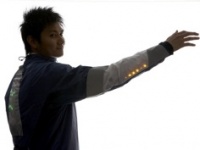When the world’s of technology and fashion mix, the results can be fascinating, brilliant and sometimes completely ridiculous.
This week London-based firm, CuteCircuit, has unveiled a creation that falls into the last category- a black dress that doubles up as a mobile phone.
Branded the M-Dress, the garment allows wearers to place a sim card into the label of the dress and using gesture recognition software, respond to calls by raising their hand or by dropping it to their side.

According to CuteCircuit, the dress is targeted at women who find it awkward to carry a mobile phone and will be unleashed on the UK market next year.
CuteCircuit is also behind the ‘Hug shirt’ which allows wearers to send a hug by transmitting heat and vibration sensors via a mobile phone’s Bluetooth to another person wearing a ‘Hug shirt’.
While these concepts may seem strange, a new generation of designers believe these creations are only the starting point for more serious and far-reaching applications of wearable technology.
The Reactiv cycling jacket is one example. Designed in 2008 by student Micheal Chen, the jacket is fitted with red, green and amber LEDs that respond to movements and warn drivers about whether a cyclist is accelerating, turning or braking.

In the world sport, athletes are already gaining real-time feedback on their performance from wearable technology that help prevent injury. For instance engineering students at Northwestern University have developed a data-logging compression shirt to help baseball pitchers avoid torn ligaments.
But perhaps even more significant are the variety of sensors integrated into fabrics that can constantly monitor the health of patients even while out of hospital, and not only provide data, but react to the situation by adjusting the temperature or sending an alarm to a healthcare worker.
Wearable technology has been around for years and its possibilities are endless. However trivial the application, getting the technology right could open up a whole new range of opportunities for engineers, and not just in the world of fashion.




Glasgow trial explores AR cues for autonomous road safety
They've ploughed into a few vulnerable road users in the past. Making that less likely will make it spectacularly easy to stop the traffic for...